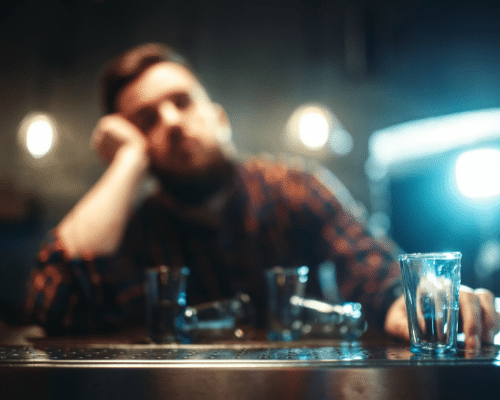The Facts on Alcoholism & How to Stay Sober on a National Drinking Holiday
It’s no secret that the Fourth of July is one of the biggest drinking holidays in the United States. Along with colorful, exploding fireworks, people bring out the booze to celebrate the anniversary of America’s freedom. In fact, the Fourth of July ranked as America’s #1 beer-drinking holiday, according to a 2016 study done by the National Beer Wholesalers Association and Fintech.
But what about those struggling with or recovering from addiction?
No matter what stage of recovery you’re in, there’s no doubt how frustrating it can be to be surrounded by people drinking heavily during a celebratory holiday. Let’s dive in a bit more on the facts about alcohol consumption and alcoholism.
What is a standard drink size?

Standard drink sizes are different depending on the type of alcohol being consumed. According to the Center for Disease Control (CDC), the following are accurate for standard drink sizes:
Beer: 12 oz. with a 5% alcohol content
Wine: 5 oz. with a 12% alcohol content
Malt: 8 oz. with a 7% alcohol content
Liquor or distilled spirit: 1.5 oz. with 40% alcohol content
Are alcohol consumption limits different for men and women?
Everyone has their limits to alcohol consumption, but from a medical standpoint, men and women each have different consumption levels that their body can tolerate. Women are actually more likely to develop alcohol-related illnesses at lower consumption levels than men. The natural body structure of women is smaller and less tolerant than men, making it easier for men to handle higher levels of alcohol consumption. Women’s blood alcohol levels stay higher for longer, even after drinking the exact same amount as a man.
The difference in alcohol consumption between men and women is so great, that the difference between what is considered “heavy drinking” is seven drinks (men: 15 a week, women: 8 a week). According to the Cleveland Clinic, “alcohol takes around 60 to 90 minutes to reach peak levels in the blood” before the body begins to break it down. But just because your “peak” period is within the first hour or so doesn’t mean the alcohol is on its way out of your system anytime soon. In fact, it takes over 24 hours for alcohol to completely leave your system from the time of your last drink.
What is considered excessive drinking?
As previously mentioned, excessive drinking for men and women are different. Men who drink 15 or more drinks a week and women who drink 8 or more a week are considered excessive drinkers. In order to be considered drinking in moderation, women can consume one beverage or less per day, and men can drink two.

How do I know if I’m an alcoholic?
Just because you drink every weekend, doesn’t mean you’re an alcoholic. However, there are some signs you and your loved ones should be paying attention to when it comes to reliance or excessive drinking.
If you notice yourself or a loved one becoming reliant on alcohol to get them through the day, this could be a sign of alcoholism. Yes, it may feel like a stress reliever to enjoy an alcoholic beverage after a long day, but if you find yourself obsessing over that drink or feeling as if you absolutely need it, it may be time to seek help.
Another sign of alcoholism is sneaking alcoholic beverages or hiding your drinking from loved ones. If you feel like you are unable to limit the amount of alcohol you’re drinking, or make failed attempts to avoid drinking, these are signs you may be struggling with alcoholism.
Other alcoholism signs include limiting your social interaction or only being able to attend social events if you’re drinking, changes in your daily routine due to hangovers or alcohol effects and drinking alcohol at inappropriate times such as at work.
No one wants to be told they’re an alcoholic. But if any of the above applies to you or a loved one, it may be time to seek treatment or advice from a substance abuse professional.
I’m in recovery, how do I stay sober on the Fourth of July?
Staying sober is definitely a challenge for those with an alcohol addiction—especially during drinking holidays or large celebrations. Follow the below tips to still have a good time without consuming alcohol.
- Surround yourself with people who understand your situation. If you celebrate with other people also in recovery from alcoholism, it will be easier to relate to each other and enjoy your time without involving alcohol at all. If you’re going to be around friends who are not in recovery, be sure to let them know you will be staying sober and enjoying nonalcoholic drinks i
 nstead. This way, you will not feel pressured when people offer you drinks or ask why you are not drinking.
nstead. This way, you will not feel pressured when people offer you drinks or ask why you are not drinking. - Bring your own beverages. There are plenty of NA beers and wines to enjoy if you feel the need to still be sipping on something. Enjoy something refreshing while also avoiding alcohol content or feeling left out.
- Prepare for temptation and know your limits. If you mentally prepare yourself for the inevitable temptation of having alcohol, the easier it will be to simply say “no thanks” and carry on. Knowing your limits of temptation or peer pressure is also important. If you feel that you’ve ended up in an uncomfortable situation, leave and enjoy the rest of your night at home enjoying some fireworks and snacks.
Synopsis:
At New Day Recovery, we work with you in whatever stage of life you’re in, and provide solutions to help you stay sober and refrain from using alcohol.




